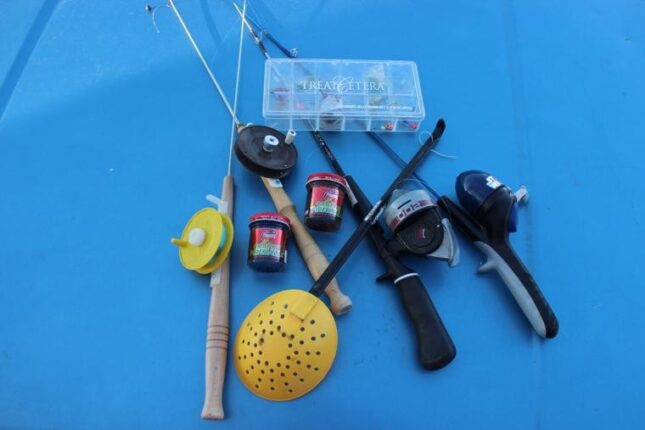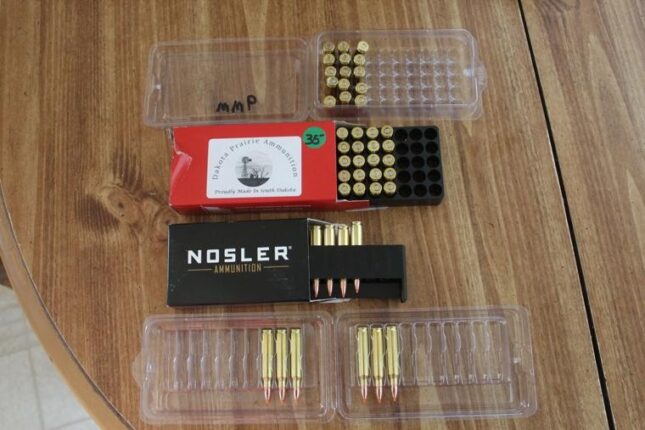The other day I wrote horror stories about ice fishing. I figured I’d better follow up with a how-to ice fishing article in case someone still had a death wish and wanted to go! I’m headed to Texas next week for a hog hunt using the Umarex Air Sabre (which is an airgun that shoots arrows). Due to being AWOL, I had to submit this story early. By the time it publishes, ice will probably be melting at CJ so you’ll probably have to go up to a mountain lake to ice fish.
It’s according to how serious you want to get. If you’re going to go every weekend, you’ll need to accumulate more gear than I’m going to recommend. You see pictures of ice fishermen up in the Northeast that have ice fishing shanties out on the ice. We won’t cover that angle.
If you’re going to ice fish regularly, I’d recommend a portable pop-up hut. You set on a bench and there are holes in the floor to line up with the holes you’ve drilled in the ice. I’ve never used any of these so sorry, I don’t know a good one to recommend.
I’ve always wondered, but never have tried it, why wouldn’t a cheap little dome tent work? Set it up and fish in it? But who knows, the bottom of the tent may freeze to the ice and become a permanent fixture until spring! So, this idea may not work.
To haul out my gear I use a cheap little red kid’s sled. Load on your gear, tie a rope on front to drag it and off you go. It should hold all of your gear but if not, throw the rest into a backpack. It’s smart to take a 20-foot rope with a thick diameter. That way if someone falls in you can throw it to them and drag them out.
I always carry a 5-gallon bucket to set on. Yes, a chair would be more comfortable but you can throw your gear in the bucket and then set it in the sled. If it’s cold you may want to take a tent heater. Or, you can build a fire.
Then, of course, you’ll need an ice auger. I have a cheaper hand auger but if you’re going to be fishing much a gas auger would be better. If they’re not biting, you need to move. Maybe you can’t troll when ice fishing but if you have a gas auger you can move more/faster. You’ll also want an ice scoop to scoop the slush out of the hole after drilling it. You’ll also use the scoop to break up ice as it starts forming on the surface of your hole.
Now for the important items. If you’re going to be drilling a lot of holes, you may want to buy cheap tip-ups to save money. I personally favor regular rods and reels. But you don’t want your regular fishing rods. You’ll want to use the short ice fishing rods. Again, I’m not a 24/7 ice fisherman so I buy cheap ice fishing rods and reels but like with all fishing, you’ll cuss less and fish more if you use quality reels.
Like with all fishing, no one lure is the silver bullet. No siree, the manufacturers have convinced us that we need a multitude of lures of different sizes and colors. I usually use the little ice fishing jigs and tip them off with a meal worm. Or, I’ve got a variety of Pautzke’s Fireballs that you can put on the jig. They’re colored and scented to help attract fish. And, they don’t die like worms do. So you can keep a bottle for … I don’t know how long, but years. That’s probably your best option because a worm isn’t going to be too lively in the frigid water below anyway, right?
For perch, I usually drop down to the bottom and reel up 8-12 inches. But like all fishing you have to check all of the water column to find out where the fish are. They even offer fish finders for ice fishermen. I’ve never used one, though, so I can’t tell you anything about them.
One good thing about ice fishing, you don’t need a stringer or a live well. Kick a little snow in a pile and throw your fish in the snow and you’re good to go. Then when you leave, just throw them into your bucket.
One last tip: due to the cold water, the fish will be a little lethargic so don’t fish your lure fast. And yes, you can jig up and down but do it slower than normal. Have fun.
Tom Claycomb lives in Idaho and has outdoors columns in newspapers in Alaska, Idaho, Utah, Nevada, Colorado and Louisiana. He also writes for various outdoors magazines and teaches outdoors seminars at stores like Cabela’s, Sportsman’s Warehouse and Bass Pro Shop. He can be reached via email at smileya7@aol.com.


